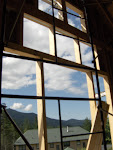There have been a number of visitors to Abode recently who have been concerned with indoor air quality. Anyone who struggles with allergies knows that clean air can be hard to find, especially this past spring. Indoor air pollution is composed of particulate matter, for example, dust, pollen, molds, and bacteria, as well as gaseous pollutants, which are given off, among others, by stoves, paints, varnishes, and cleaning products. According to the EPA, poor indoor air quality is among the top five environmental health risks. But take a deep breath, there are many methods to get cleaner air.
 As we learn more about indoor air quality’s contribution to health problems, using low volatile organic compound (VOC) paints and carpeting, as well as having an air filtration system in our homes becomes an evident necessity. Efficiency of removing particles from the air is measured by the minimum efficiency reporting value (MERV), with a scale from 1 to 20. Medium efficiency filters from MERV 5-13 are reasonably efficient at removing a range of airborne particles. Heat Recovery Ventilation (HRV) is also beneficial up north here, where like it or not, it is cold at least 8 months out of the year. HRV systems allow the heat from the exiting air to transfer to the incoming air, increasing your home’s heating/cooling efficiency. For more information about indoor air quality check out http://www.epa.gov/iaq/ia-intro.html.
As we learn more about indoor air quality’s contribution to health problems, using low volatile organic compound (VOC) paints and carpeting, as well as having an air filtration system in our homes becomes an evident necessity. Efficiency of removing particles from the air is measured by the minimum efficiency reporting value (MERV), with a scale from 1 to 20. Medium efficiency filters from MERV 5-13 are reasonably efficient at removing a range of airborne particles. Heat Recovery Ventilation (HRV) is also beneficial up north here, where like it or not, it is cold at least 8 months out of the year. HRV systems allow the heat from the exiting air to transfer to the incoming air, increasing your home’s heating/cooling efficiency. For more information about indoor air quality check out http://www.epa.gov/iaq/ia-intro.html.
 As we learn more about indoor air quality’s contribution to health problems, using low volatile organic compound (VOC) paints and carpeting, as well as having an air filtration system in our homes becomes an evident necessity. Efficiency of removing particles from the air is measured by the minimum efficiency reporting value (MERV), with a scale from 1 to 20. Medium efficiency filters from MERV 5-13 are reasonably efficient at removing a range of airborne particles. Heat Recovery Ventilation (HRV) is also beneficial up north here, where like it or not, it is cold at least 8 months out of the year. HRV systems allow the heat from the exiting air to transfer to the incoming air, increasing your home’s heating/cooling efficiency. For more information about indoor air quality check out http://www.epa.gov/iaq/ia-intro.html.
As we learn more about indoor air quality’s contribution to health problems, using low volatile organic compound (VOC) paints and carpeting, as well as having an air filtration system in our homes becomes an evident necessity. Efficiency of removing particles from the air is measured by the minimum efficiency reporting value (MERV), with a scale from 1 to 20. Medium efficiency filters from MERV 5-13 are reasonably efficient at removing a range of airborne particles. Heat Recovery Ventilation (HRV) is also beneficial up north here, where like it or not, it is cold at least 8 months out of the year. HRV systems allow the heat from the exiting air to transfer to the incoming air, increasing your home’s heating/cooling efficiency. For more information about indoor air quality check out http://www.epa.gov/iaq/ia-intro.html. 
